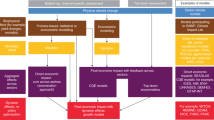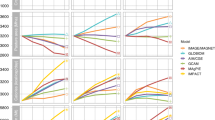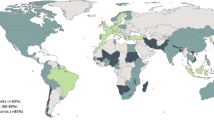Abstract
There are great uncertainties in the projected economic impacts of climate change1, arising from uncertainties in the climate response2, the climate change mitigation pathway3 and the socioeconomic development pathway4. Although the relative contributions of these factors are important for climate change related decision-making, they are poorly understood. Here, we show to what extent the projected economic impacts of climate change can be attributed to these three factors. Our modelling framework consisting of global, multisectoral impact models coupled with an integrated assessment model enables us to estimate the global total economic impacts of climate change while incorporating these uncertainty sources. Whereas the most pessimistic pathway without mitigation would result in a net economic impact equivalent to 6.6% (3.9–8.6%) of global gross domestic product at the end of this century, the pathways with stringent mitigation would limit the impact to around or less than 1%. Although the uncertainties are great, the climate change mitigation pathway is the dominant factor and socioeconomic developments can also contribute to alleviate the impacts of climate change. These results suggest that decisions on mitigation and development have a great influence in determining the economic impacts of climate change, regardless of the uncertainties in the climate response.
This is a preview of subscription content, access via your institution
Access options
Access Nature and 54 other Nature Portfolio journals
Get Nature+, our best-value online-access subscription
$29.99 / 30 days
cancel any time
Subscribe to this journal
Receive 12 print issues and online access
$209.00 per year
only $17.42 per issue
Buy this article
- Purchase on Springer Link
- Instant access to full article PDF
Prices may be subject to local taxes which are calculated during checkout




Similar content being viewed by others
Data availability
Data required to reproduce the main results are available in the Supplementary Datasets and Code.
Code availability
Computer code required to reproduce the main results are available in Supplementary Datasets and Code.
Change history
07 October 2019
An amendment to this paper has been published and can be accessed via a link at the top of the paper.
23 January 2024
A Correction to this paper has been published: https://doi.org/10.1038/s41558-024-01930-6
References
Arent, D. J. et al. in Climate Change 2014: Impacts, Adaptation, and Vulnerability (eds Field, C. B. et al.) 659–708 (IPCC, Cambridge Univ. Press, 2014).
Knutti, R. & Sedláček, J. Robustness and uncertainties in the new CMIP5 climate model projections. Nat. Clim. Change 3, 369–373 (2012).
van Vuuren, D. P. et al. The representative concentration pathways: an overview. Climatic Change 109, 5 (2011).
O'Neill, B. C. et al. A new scenario framework for climate change research: the concept of shared socioeconomic pathways. Climatic Change 122, 387–400 (2013).
Smith, L. A. & Stern, N. Uncertainty in science and its role in climate policy. Phil. Trans. R. Soc. Lond. A 369, 4818–4841 (2011).
Schelling, T. C. Micromotives and Macrobehavior (WW Norton, 2006).
Morgan, M. G., Henrion, M. & Small, M. Uncertainty: A Guide to Dealing with Uncertainty in Quantitative Risk and Policy Analysis (Cambridge Univ. Press, 1992).
Bosshard, T. et al. Quantifying uncertainty sources in an ensemble of hydrological climate‐impact projections. Water Resour. Res. 49, 1523–1536 (2013).
Tol, R. S. J. Estimates of the damage costs of climate change. Part 1: Benchmark estimates. Environ. Resour. Econ. 21, 47–73 (2002).
Stern, N. The Economics of Climate Change: The Stern Review (Office of Climate Change, 2006).
Ciscar, J.-C. et al. Physical and economic consequences of climate change in Europe. Proc. Natl Acad. Sci. USA 108, 2678–2683 (2011).
Roson, R. & Van der Mensbrugghe, D. Climate change and economic growth: impacts and interactions. Int. J. Sustain. Econ. 4, 270–285 (2012).
Hsiang, S. et al. Estimating economic damage from climate change in the United States. Science 356, 1362–1369 (2017).
Nordhaus, W. D. Revisiting the social cost of carbon. Proc. Natl Acad. Sci. USA 114, 1518–1523 (2017).
Dellink, R., Lanzi, E. & Chateau, J. The sectoral and regional economic consequences of climate change to 2060. Environ. Resour. Econ. 72, 309–363 (2017).
Burke, M., Hsiang, S. M. & Miguel, E. Global non-linear effect of temperature on economic production. Nature 527, 235–239 (2015).
Burke, M., Davis, W. M. & Diffenbaugh, N. S. Large potential reduction in economic damages under UN mitigation targets. Nature 557, 549–553 (2018).
Roson, R. & Sartori, M. Estimation of climate change damage functions for 140 regions in the GTAP 9 data base. J. Global Econ. Anal. 1, 78–115 (2016).
Fujimori, S., Masui, T. & Matsuoka, Y. AIM/CGE [Basic] Manual Discussion Paper No. 2012-01 (Center for Social and Environmental Systems Research, NIES, 2012).
Riahi, K. et al. The shared socioeconomic pathways and their energy, land use, and greenhouse gas emissions implications: an overview. Glob. Environ. Change 42, 153–168 (2017).
Meinshausen, M. et al. The RCP greenhouse gas concentrations and their extensions from 1765 to 2300. Climatic Change 109, 213–241 (2011).
McSweeney, C. F. & Jones, R. G. How representative is the spread of climate projections from the 5 CMIP5 GCMs used in ISI-MIP? Clim. Serv. 1, 24–29 (2016).
Howard, P. H. & Sterner, T. Few and not so far between: a meta-analysis of climate damage estimates. Environ. Resour. Econ. 68, 197–225 (2017).
Rosenzweig, C. et al. Assessing inter-sectoral climate change risks: the role of ISIMIP. Environ. Res. Lett. 12, 010301 (2017).
Nishina, K. et al. Decomposing uncertainties in the future terrestrial carbon budget associated with emission scenarios, climate projections, and ecosystem simulations using the ISI-MIP results. Earth Syst. Dynam. 6, 435–445 (2015).
Emori, S. et al. Risk implications of long-term global climate goals: overall conclusions of the ICA-RUS project. Sustain. Sci. 13, 279–289 (2018).
Lamontagne, J. R. et al. Large ensemble analytic framework for consequence-driven discovery of climate change scenarios. Earth’s Future 6, 488–504 (2018).
Crespo Cuaresma, J. Income projections for climate change research: a framework based on human capital dynamics. Glob. Environ. Change 42, 226–236 (2017).
Kc, S. & Lutz, W. The human core of the shared socioeconomic pathways: population scenarios by age, sex and level of education for all countries to 2100. Glob. Environ. Change 42, 181–192 (2017).
Jiang, L. & O’Neill, B. C. Global urbanization projections for the Shared Socioeconomic Pathways. Glob. Environ. Change 42, 193–199 (2017).
Burke, M. B., Miguel, E., Satyanath, S., Dykema, J. A. & Lobell, D. B. Warming increases the risk of civil war in Africa. Proc. Natl Acad. Sci. USA 106, 20670–20674 (2009).
Ranson, M. Crime, weather, and climate change. J. Environ. Econ. Manag. 67, 274–302 (2014).
Hempel, S., Frieler, K., Warszawski, L., Schewe, J. & Piontek, F. A trend-preserving bias correction—the ISI-MIP approach. Earth Syst. Dynam. 4, 219–236 (2013).
Iizumi, T., Takikawa, H., Hirabayashi, Y., Hanasaki, N. & Nishimori, M. Contributions of different bias‐correction methods and reference meteorological forcing data sets to uncertainty in projected temperature and precipitation extremes. J. Geophys. Res. 122, 7800–7819 (2017).
Iizumi, T. et al. Responses of crop yield growth to global temperature and socioeconomic changes. Sci. Rep. 7, 7800 (2017).
Iizumi, T. et al. Crop production losses associated with anthropogenic climate change for 1981–2010 compared with preindustrial levels. Int. J. Climatol. 38, 5405–5417 (2018).
Rosenzweig, C. et al. Assessing agricultural risks of climate change in the twenty-first century in a global gridded crop model intercomparison. Proc. Natl Acad. Sci. USA 111, 3268 (2014).
Fujimori, S. et al. Macroeconomic impacts of climate change driven by changes in crop yields. Sustainability 10, 3673 (2018).
Hasegawa, T., Fujimori, S., Takahashi, K., Yokohata, T. & Masui, T. Economic implications of climate change impacts on human health through undernourishment. Climatic Change 136, 189–202 (2016).
Mortality Risk Valuation in Environment, Health and Transport Policies (OECD, 2012).
Honda, Y. et al. Heat-related mortality risk model for climate change impact projection. Environ. Health Prev. Med. 19, 56–63 (2014).
Hasegawa, T. et al. Quantifying the economic impact of changes in energy demand for space heating and cooling systems under varying climatic scenarios. Palgrave Commun. 2, 16013 (2016).
Park, C. et al. Avoided economic impacts of energy demand changes by 1.5 and 2 °C climate stabilization. Environ. Res. Lett. 13, 045010 (2018).
Isaac, M. & Van Vuuren, D. P. Modeling global residential sector energy demand for heating and air conditioning in the context of climate change. Energy Policy 37, 507–521 (2009).
Fujimori, S., Masui, T. & Matsuoka, Y. Development of a global computable general equilibrium model coupled with detailed energy end-use technology. Appl. Energy 128, 296–306 (2014).
Takakura, J. et al. Cost of preventing workplace heat-related illness through worker breaks and the benefit of climate-change mitigation. Environ. Res. Lett. 12, 064010 (2017).
Budd, G. M. Wet-bulb globe temperature (WBGT)—its history and its limitations. J. Sci. Med. Sport 11, 20–32 (2008).
Jacklitsch, B. et al. Criteria for a Recommended Standard: Occupational Exposure to Heat and Hot Environments: Revised Criteria 2016–2106 (NIOSH, 2016).
Zhou, Q., Hanasaki, N., Fujimori, S., Masaki, Y. & Hijioka, Y. Economic consequences of global climate change and mitigation on future hydropower generation. Climatic Change 147, 77–90 (2018).
Hanasaki, N. et al. An integrated model for the assessment of global water resources—Part 1: Model description and input meteorological forcing. Hydrol. Earth Syst. Sci. 12, 1007–1025 (2008).
Hanasaki, N. et al. An integrated model for the assessment of global water resources—Part 2: Applications and assessments. Hydrol. Earth Syst. Sci. 12, 1027–1037 (2008).
Zhou, Q. et al. Cooling water sufficiency in a warming world: projection using an integrated assessment model and a global hydrological model. Water 10, 872 (2018).
Zhou, Q., Hanasaki, N. & Fujimori, S. Economic consequences of cooling water insufficiency in the thermal power sector under climate change scenarios. Energies 11, 1–11 (2018).
Kinoshita, Y., Tanoue, M., Watanabe, S. & Hirabayashi, Y. Quantifying the effect of autonomous adaptation to global river flood projections: application to future flood risk assessments. Environ. Res. Lett. 13, 014006 (2018).
Tanoue, M., Hirabayashi, Y. & Ikeuchi, H. Global-scale river flood vulnerability in the last 50 years. Sci. Rep. 6, 36021 (2016).
Yamazaki, D., Kanae, S., Kim, H. & Oki, T. A physically based description of floodplain inundation dynamics in a global river routing model. Water Resour. Res. 47, W04501 (2011).
Takata, K., Emori, S. & Watanabe, T. Development of the minimal advanced treatments of surface interaction and runoff. Glob. Planet. Change 38, 209–222 (2003).
Ikeuchi, H. et al. Modeling complex flow dynamics of fluvial floods exacerbated by sea level rise in the Ganges–Brahmaputra–Meghna Delta. Environ. Res. Lett. 10, 124011 (2015).
Klein Goldewijk, K., Beusen, A., van Drecht, G. & de Vos, M. The HYDE 3.1 spatially explicit database of human-induced global land-use change over the past 12,000 years. Glob. Ecol. Biogeogr. 20, 73–86 (2011).
Tsuchida, K., Tamura, M., Kumano, N., Masunaga, E. & Yokoki, H. Global impact and uncertainty assessment of sea level rise based on multiple climate models. J. Jpn Soc. Civ. Eng. G 74, 1167–1174 (2018).
Yotsukuri, M., Tamura, M., Kumano, N., Masunaga, E. & Yokoki, H. Global impact assessment of sea level rise based on RCP/SSP scenarios. J. Jpn. Soc. Civ. Eng. G 73, I369–I376 (2017).
Tamura, M., Kumano, N., Yotsukuri, M. & Yokoki, H. Global assessment of the effectiveness of adaptation in coastal areas based on RCP/SSP scenarios. Climatic Change 152, 363–377 (2019).
EM-DAT: The International Disaster Database (CRED, accessed 1 November 2015); http://www.emdat.be/
Matsumoto, K. I. Climate change impacts on socioeconomic activities through labor productivity changes considering interactions between socioeconomic and climate systems. J. Clean. Prod. 216, 528–541 (2019).
Fujimori, S. et al. SSP3: AIM implementation of Shared Socioeconomic Pathways. Glob. Environ. Change 42, 268–283 (2017).
Honaker, J., King, G. & Blackwell, M. Amelia II: a program for missing data. J. Stat. Softw. 45, 47 (2011).
Acknowledgements
This research was supported by the Environment Research and Technology Development Fund (no. S-14) of the Environmental Restoration and Conservation Agency.
Author information
Authors and Affiliations
Contributions
S.F., N.H., T.H., Y.Hirabayashi, Y.Honda, T.I., N.K., C.P., Z.S., K.Takahashi., J.T., M.Tamura., M.Tanoue, K.Tsuchida, H.Y. and Q.Z. conducted analyses on the sectoral impacts and provided the data. J.T. conducted the analysis of the aggregated impacts. J.T. and S.F. wrote the manuscript. T.O. and Y.Hijioka directed the study. All authors participated in the interpretation of the results, discussion and revising the draft of the manuscript.
Corresponding author
Ethics declarations
Competing interests
J.T. was employed by Toshiba Corporation, which is associated with the manufacture, sale, distribution and marketing of hydro/thermal power plants, until February 2016. K.Tsuchida has been employed by Nippon Koei, which is associated with consultation on natural disaster prevention (including fluvial flooding and coastal inundation) and on hydro/thermal power plants, since April 2019. The other authors declare no competing interests.
Additional information
Peer review information Nature Climate Change thanks Roberto Roson and the other, anonymous, reviewer(s) for their contribution to the peer review of this work.
Publisher’s note Springer Nature remains neutral with regard to jurisdictional claims in published maps and institutional affiliations.
Supplementary information
Supplementary Information
Supplementary Figs. 1–23, Discussions 1–4, Tables 1–5, Methods 1–4 and references.
Supplementary Datasets and Code
Supplementary datasets and code to reproduce main results.
Rights and permissions
About this article
Cite this article
Takakura, J., Fujimori, S., Hanasaki, N. et al. Dependence of economic impacts of climate change on anthropogenically directed pathways. Nat. Clim. Chang. 9, 737–741 (2019). https://doi.org/10.1038/s41558-019-0578-6
Received:
Accepted:
Published:
Issue Date:
DOI: https://doi.org/10.1038/s41558-019-0578-6
This article is cited by
-
Climate change mitigation costs reduction caused by socioeconomic-technological transitions
npj Climate Action (2023)
-
Sustainable development substantially reduces the risk of future drought impacts
Communications Earth & Environment (2023)
-
Challenges resulting from urban density and climate change for the EU energy transition
Nature Energy (2023)
-
Impacts of social capital on climate change adaptations of banana farmers in Southern China
Environment, Development and Sustainability (2023)
-
Potential side effects of climate change mitigation on poverty and countermeasures
Sustainability Science (2023)



